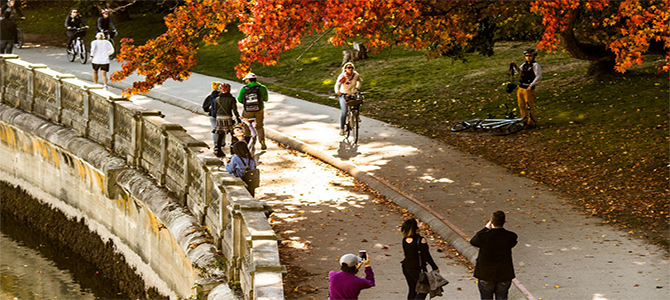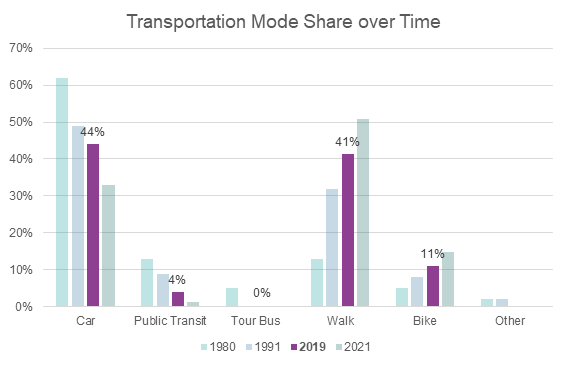
 Preparing for the transport needs of the next century of visitors to Stanley Park
Preparing for the transport needs of the next century of visitors to Stanley Park
Last night, the Park Board heard the latest progress of the Stanley Park Mobility Study PDF file (4.6 MB) and approved the guiding principles leading the next steps.
The transportation system within Stanley Park was developed in 1888 - 133 years ago - and it has changed little since then. While it has served visitors well over the past century, the ways people access and move through the park have evolved significantly. With over 18 million visits a year in 2021, a growing population and increasing tourism, changes are needed to ensure the park continues to thrive and provide great experiences for the next century.
The Stanley Park Mobility Study’s goal is to improve experience by exploring options that improve access to and movement around the park, while reducing private vehicle traffic. It is a high-level study investigating - not just the current temporary bike lane – but all options for movement within one of Canada’s most well-loved parks. Using 2019 as its baseline, the study tracks park usage from 1980 to now, and looks at how other jurisdictions have handled traffic and mobility in comparable global destination parks.
Key findings
The latest findings of the study show:
- More people are coming to Stanley Park than ever before (18M visits in 2021).
- Of those, more people are walking, rolling, or cycling to and through the park, while private vehicle traffic has continued to decline over the past 40 years.
- The current transportation network in the park is not set up to support the ever-increasing number of visitors to the park, or the changing ways people access and move through the park.
Other notable findings:
- The highest priority, for those surveyed during this early engagement phase, is to ensure the park is accessible for all, particularly people with mobility challenges, while improving park experience.
- The majority reported they believe the park experience is improved by reducing vehicle traffic while supporting accessible and equitable access for all.
- 70% of respondents see an opportunity to reduce vehicle traffic within the park, citing:
- Less noise and pollution
- More space for other modes of transport
- A safer network
- Potential to reallocate asphalt to other uses or green space
- Less congestion
- More opportunities for businesses
- Other jurisdictions that have reduced vehicle traffic within destination parks have seen growth in visitor numbers.
Park Drive was originally built in 1888 to allow for “pleasure drives” around the park when the population of Metro Vancouver was 26,000. Since then, the population has grown to more than 2,600,000. Stanley Park has also become the number-one tourist attraction in the region, and one of the most significant in the country, attracting millions of tourists per year. Yet, Park Drive, and mobility in the park in general, has remained largely unchanged for the past century.
An estimated 18 million visitors came to the park in 2021, which is a significant increase from previous estimates of 8 to 10 million in 2016. Since 1980, vehicle traffic has almost halved while pedestrian and other forms of transportation have increased. The study is full of new statistics and information including:
- In 1980, over 60% of people accessed the park by private vehicle, compared to 41% in 2019 and 33% in 2021. In 2019, 66% of all paved surfaces in the park were dedicated to private vehicle traffic.
- In 1980, people who are walking or rolling to the park made up only 12%, compared to 41% in 2019 and more than 50% in 2021.
- Cycling increased from 5% in 1980, to 11% in 2019, and to 15% in 2021 – a trend influenced by supportive cycling infrastructure within City and the park.
- Public transit usage has decreased since 1980 and remains the least utilized way of getting to the park.

Engagement
Beyond visitor data, we engaged the public and stakeholder groups on access to the park from 2020 to today. In both 2020 and 2021, we fielded surveys examining public sentiment on the COVID-19 response and temporary separated bike lane, with strong support for restricting vehicle access while maintaining accessibility. In spring of 2022, we launched early engagement on the mobility study with another public survey and engagement with community and organizational stakeholders, including outreach to some businesses in the park. The final engagement results will be published in an engagement report in fall 2022.
Guiding principles
The newly approved guiding principles will help us assess options for improving access to Stanley Park, while supporting a reduction in private vehicle traffic as park visitation trends evolve and the urgency of the climate crisis intensifies. The guiding principles are underpinned by two foundational values through which every option will be assessed: Reconciliation and equity.
The seven guiding principles are:
- Safety
- Accessibility
- Economic vitality
- Climate action and environmental protection
- A flexible and resilient system
- A connected transportation network
- An enhanced park experience
Next steps
From here, we will continue with the study, including studying the economic benefits of the park and climate impacts of reducing private vehicle traffic in Stanley Park, before reporting on recommended options for a new vision for mobility in the park in early 2023.
About the Stanley Park Mobility Study
The Stanley Park Mobility Study is a long-term assessment of how people travel to and move through Vancouver’s biggest tourist attraction and an evaluation of options for the potential reduction of vehicle traffic while improving access and experience for all.
On June 8, 2020, the Park Board carried a motion to direct staff to: “explore the long-term feasibility of reducing motor vehicle traffic in Stanley Park, including but not restricted to, reducing roadways to single lanes while maintaining access to the park, while increasing accessibility for those with disabilities”. This motion established the need for the Stanley Park Mobility Study, separate from but informing the Stanley Park Comprehensive Plan.
The study builds on previous mobility studies from 1989, 1996, and 2012, and the ongoing work of the Stanley Park Comprehensive Plan.
It is anticipated that the final report and options will be presented to the Park Board in early 2023.